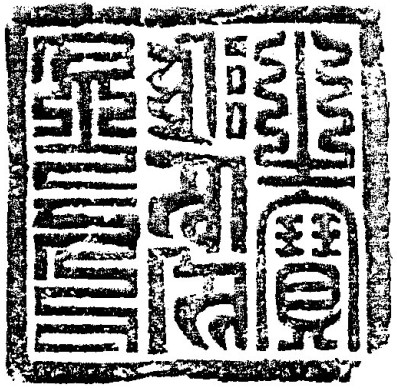BabelStone Blog
Friday, 4 May 2007
The Emperor's Treasure
In my spare time (!) I am collecting material for a Dictionary of Phags-pa (Chinese, Mongolian, Uighur, Sanskrit written in the Phags-pa script), which should be ready for publication in ten or twenty years time at the current rate of progress. In the meantime I thought I would post about a couple of Phags-pa inscriptions that I am having difficulty with, in the hope that some of my kind readers may be able to help me out.
The first is a Yuan dynasty seal with an inscription in three scripts, Phags-pa on the left, Lantsa (Sanskrit) in the middle, and Chinese (之寶) on the right :
Ye Qifeng, A General Survey of Ancient Chinese Seals (Beijing, 2003) Fig.77.
This seal was included by Luo Zhenyu 羅振玉 (1866-1940) in his Sui-Tang Yilai Guanyin Jicun 隋唐以来官印集存 (Collection of official seals from the Sui and Tang dynasties and later), published in 1916, where he interprets the Phags-pa text as reading huang di 皇帝 "Emperor". Reading the left column (Phags-pa) and then the right column (Chinese) this gives the inscription huang di zhi bao 皇帝之寶 "the Emperor's treasure".
The problem is that the expected Phags-pa spelling for huang di 皇帝 is xong di ꡣꡡꡃ ꡊꡞ, and the seal has xong d-ėi ꡣꡡꡃ ꡊꡖꡦꡞ (shown below in normal book style Phags-pa letters) :

Whereas, according to Menggu Ziyun 蒙古字韻, xong is the normal Phags-pa spelling for huang 皇 "Emperor" (also huang 黄 "yellow", etc.), the syllable d-ėi ꡊꡖꡦꡞ that follows it most definitely is not the normal Phags-pa spelling for di 帝. This strange concatenation of letters (DA ꡊ plus -A ꡖ plus Ė ꡦ plus I ꡞ) makes no sense at all. Although in Mongolian and Sanskrit the letter -A can occur medially to indicate a long vowel (e.g. in the word q-an ꡢꡖꡋ "khan", which corresponds to standard Mongolian qaɣan ᠬᠠᠭᠠᠨ), in Chinese Phags-pa orthography the letter -A only occurs initially. Then there is the final diphthong ėi ꡦꡞ, which in Chinese Phags-pa orthography only occurs after the letters KA ꡀ, KHA ꡁ, GA ꡂ and HA ꡜ, and does not occur in either Mongolian or Sanskrit Phags-pa. So the syllable d-ėi ꡊꡖꡦꡞ does not accord to the orthographic rules for writing Chinese or Mongolian in the Phags-pa script, which is very strange indeed if this seal did indeed belong to an emperor of the Yuan dynasty, as you would not expect anyone to get away with a gross misspelling error such as this on the seal of an emperor.
If d-ėi ꡊꡖꡦꡞ is not an accidental misspelling for di ꡊꡞ then it must be deliberate, but why I am at a loss to explain. My best guess is that the letters -A ꡖ and Ė ꡦ were inserted into the syllable di as fillers to make up space, so that the line of Phags-pa text filled up the entire lefthand column. However, on Phags-pa seals this problem is usually solved by using complex glyph variants of letters that take up more space than normal, especially the letters i and u which may be written with multiple spirals, so it would have been possible to extend the syllable di by using a convoluted version of the letter i (like ꡊꡞ if you have BabelStone Phags-pa Seal installed).
And finally there is the line of Sanskrit text written in Lantsa script. I may well be wrong, but to me this looks as if it reads as :
thrāḥ
svā
sti
However thrāḥ svā sti is not a mantra either I or Google are familiar with, so if anyone can tell me what it means or suggest a better reading of the Lantsa text I will be very grateful.
Index of BabelStone Blog Posts
